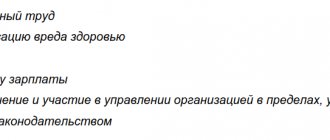Administrative and managerial personnel - what is it?
Before considering the very concept of AUP and its interpretation as administrative and managerial personnel, you should familiarize yourself with the basic principles of forming the personnel structure in the organization. Thus, despite the fact that the personnel structure in many cases is developed individually, taking into account the characteristics of a particular business entity, the employees of an enterprise can often be divided according to various criteria. The most popular separation technique now is to divide employees into two fundamental groups:
- Administrative and management personnel. It includes employees who are engaged in management activities or ensure the existence of the enterprise itself by solving key administrative functions within the framework of their work activities.
- Production personnel. This category includes the line personnel of the organization - both qualified specialists who are performers and ordinary employees with a minimum level of qualifications. At the same time, production personnel mainly include employees who ensure the direct receipt of profit by the enterprise, but lower-level service employees can also be classified as such.
From the point of view of Russian legislation, such a division of employees is not reflected in regulatory documents in any way. The only documents that indirectly address this issue can be unified qualification directories of professions - they are divided into a directory of blue-collar professions and a directory of employees. And administrative and managerial personnel in most situations belong specifically to the category of employees.
Legal regulation of the activities of administrative and managerial personnel, accordingly, remains under the jurisdiction of the employer himself. It is he who can regulate the division of employees into various groups, the procedure for applying various remuneration systems in relation to employees, as well as establish rules of subordination in the enterprise, which are quite important for the administrative and managerial staff of the organization.
What is work experience in a specialty?
Within the framework of the current legislation of the Russian Federation, the term is not disclosed, however, there are several regulations in which it is mentioned, for example, Art. 256 Labor Code of the Russian Federation. It says that accrual is carried out while on leave to care for a minor child.
Regarding military personnel, the term is mentioned in Part 3 of Art. 10 Federal Law No. 76 dated May 27, 1998. According to this norm, the period of contract service is calculated 1 to 1, and conscription - 1 to 2. Alternative service is also included during work in the specialty (Part 2 of Article 19 Federal Law No. 113 dated July 25 .2002).
Experience is required in order to obtain a certificate of admission to SRO (to perform certain types of construction work). In accordance with Part 8 of Art. 55.5 of the Town Planning Code of the Russian Federation, to obtain a certificate, the duration of work must be 5 years or more.
If we are talking about qualification requirements regarding work experience, they are indicated for employees individually, depending on the nature of their activities. These standards are determined within the framework of current federal and regional legislation and contain a whole list of nuances.
The importance of the insurance period when calculating sick leave benefits
To calculate sick leave benefits, the period of time when a person worked or performed other activities, but insurance payments were made, is taken into account. Depending on how long the insurance period is, the benefit is calculated in this amount. Accordingly, the larger it is, the greater the payment.
The calculation standards will be as follows:
- If the insured employee has worked for 5 years, then sick leave benefits are calculated in the amount of 60% of his monthly salary.
- When an employee has 5-8 years of work experience, the payment will be 80%.
- More than 8 years of work – 100%.
- In cases where the insured person works no more than six months, the benefit will be 1% (no more) of the salary, taking into account the regional coefficient.
Coaching - what is it
In a broad sense, coaching is a technique for teaching a person independence in achieving goals and finding optimal solutions that will lead to set goals.
A coach is a kind of trainer and mentor, however, unlike most existing motivation methods, he does not focus his ward on previous, most often negative, experiences, but directs him to the future.
The coach only pushes the person in the right direction, offering to see not problems, but situations from different sides. The effectiveness of this motivation technique is based on revealing the internal potential of the individual, following the already established successful experience.
There are several types of coaching:
- Management (business) coaching - the audience for this type of training is the management and personnel of companies. They learn to see a specific goal for the continued existence of the business and build feedback connections between management and employees. After applying coaching methods, the company’s team forms a team of like-minded people who together strive to achieve their goal.
- Career coaching is aimed at identifying a person’s potential in building their own career.
- Life coaching helps the client cope with various situations in the personal sphere and achieve what they want.
Coaching is carried out in the form of an individual or group conversation. As a rule, there are two methods of leading a client to a goal: mentoring and partnership.
The mentoring (mentoring) method consists of training a client by a specialist who has some authority and experience in the area where the student wants to achieve a certain result. With this type of motivation, the specialist sets an example for his ward and becomes a guide to his goal.
Affiliate is that the coach learns simultaneously with the client, draws his attention to those shortcomings that delay the moment of achieving the goal.
For example, when learning to drive a car, classes with an instructor who shows how to drive a car correctly, suggests possible ways out of controversial situations, is a mentoring method.
The partner method is that the coach knows the methodology for teaching effective driving, however, he is not an instructor.
Here the student is told what to pay attention to in order to better learn how to drive a car, and how to organize the stages of training and training.
The concept of total work experience
The total length of service, which includes all periods of work, as well as socially useful activities of a citizen, plays a special role in taking into account the periods of work before 01/01/2002 in the calculation of pensions. After this date, in connection with the entry into force of the Law “On Labor Pensions in the Russian Federation” dated December 17, 2001 No. 173-FZ, this concept is replaced by the definition of “insurance period”, information about which begins to accumulate directly in the Pension Fund.
For information about how the Pension Fund receives information about the insurance experience and income of each person, read the article “From what year was personalized accounting introduced?”
Fundamentally, these 2 types of length of service are distinguished by the fact that the general length of service takes into account the periods of labor and socially useful activities carried out by the citizen, and the insurance period takes into account the periods of payment of contributions from his income to the Pension Fund. With the introduction of Law No. 173-FZ of December 17, 2001, the size of the pension began to depend on different values depending on the period of labor activity:
- for the period before 01/01/2002 - on the duration of the total length of service and the amount of average monthly earnings;
- for the period from 01/01/2002 - from the amount of contributions paid to the Pension Fund and the presence of a minimum insurance period.
The new and old algorithms for calculating pensions turned out to be incomparable. Pension rights earned by a citizen before 01/01/2002 could not be taken into account when applying the new rules without appropriate data linking. For this purpose, paragraph 1 of Art. 30 of Law No. 173-FZ of December 17, 2001 provided for the possibility of recalculating these rights into an amount comparable to the new rules: the estimated pension capital accumulated on the date of the change in legislation. The formula for calculating this capital includes the value of the estimated size of the labor pension, which can be determined by one of 2 algorithms given, respectively, in clause 3 or clause 4 of Art. 30 of the law of December 17, 2001 No. 173-FZ.
Where is experience accounting applied?
Both types of length of service are taken into account by employees of the Russian pension fund when calculating pension payments to a person entering a well-deserved retirement. The new pension reform, which unfolded in 2015, uses points as the main unit for calculating pension payments, not months or rubles of savings. The number of points accumulated directly depends on the time during which insurance premiums were paid.
The later a citizen applies for a pension, the more points will accumulate in his account, and, accordingly, the larger the pension.
Addition of periods of labor and insurance experience
If part of a person’s work activity occurred before 2002, then the periods of labor and insurance experience are added together. According to Decree of the Government of the Russian Federation No. 1015, a citizen in such a situation must present to the pension fund a work book that contains records of the entire duration of his work activity. Pension Fund employees calculate labor points based on the total length of work experience up to 2002, after which they index them. The indexed points are added to the pension points that the employee accumulated after the entry into force of Law No. 167.
Elena Smirnova
Pension lawyer, ready to answer your questions.
Ask me a question
If a person has lost his work record, and he was unable to prove the fact of working before 2002, then he can only count on a minimum old-age pension.
Types of total length of service that affect the calculation of pensions
Differences in establishing the estimated size of a labor pension are not limited to the difference in the formulas for their calculation: the lists of periods that form the total length of service involved in them also differ.
For calculations according to clause 3 of Art. 30 of the law of December 17, 2001 No. 173-FZ, the total length of service consists of the periods:
- any types of work (including creative activities) in the Russian Federation or abroad;
- military service;
- illness that occurred during work, or disability of 1-2 groups related to work;
- unjustified excessive detention;
- registration with the employment service in connection with unemployment.
For calculations according to clause 4 of Art. 30 of Law No. 173-FZ of December 17, 2001, the total length of service, in addition to the above periods, additionally includes the time:
- vocational training;
- caring for a disabled person;
- maternity leave and child care up to 3 years (but not more than 9 years);
- lack of opportunity to work for the wives of military personnel staying with their husbands at the place of service, and the wives of persons sent to work abroad. In the latter case, this period should not exceed 10 years;
- being in the occupied territories, in concentration camps or in besieged Leningrad during the Second World War.
See also “Is military service included in seniority (nuances)?”
What is included in the length of service and how to calculate the periods?
The periods included in the total length of service are taken into account in this calculation according to their actual calendar duration by summation (clauses 3–4 of Article 30 of Law No. 173-FZ of December 17, 2001). However, there are a number of exceptions, according to which the corresponding intervals are taken into account in an increased amount. For example, for both options for determining the total length of service for a full year, the time worked during a full season in seasonal industries is taken.
In calculating the length of service under clause 4 of Art. 30 of the Law of December 17, 2001 No. 173-FZ additionally increases the time:
- work in the Far North, in areas equivalent to it, in the zone of the Chernobyl accident - 1.5 times;
- conscript service in the army, work in leper colonies, anti-plague institutions, work during the Second World War (except for areas of occupation), living in besieged Leningrad, being in a concentration camp - 2 times;
- participation in hostilities and service in the zone of the Chernobyl accident, treatment of war injuries, work in besieged Leningrad, unjustified detention in places of detention - 3 times.
Explanations from officials about the order in which periods of conscription service in the army and periods of study at universities are included in the general length of service and insurance experience are available in the ConsultantPlus system. Get trial access to K+ for free and proceed to conclusions.
The right to choose a calculation formula and, accordingly, to evaluate the total length of service is reserved by law to the insured person. However, in practice, such a calculation is made by the Pension Fund based on the documents it has, choosing from 2 options the most profitable for the pensioner.
The length of service is assessed in years, months and days. In this case, 30 calendar days are taken for a full month, and 12 months for a year (clause 47 of the Government of the Russian Federation Resolution No. 1015 of October 2, 2014 and clause 35 of the previous Government Resolution of the Russian Federation dated July 24, 2002 No. 555).
Counting the period of military and army service into the insurance period
According to current laws, in order to calculate sick leave benefits, the period during which the man was in the armed forces is included in the insurance period. But here it is necessary to clarify the point that if this period was after 01/01/2007, then benefits are not paid. When this moment significantly reduces payments, they are compensated from the state budget.
For example, consider the following situation:
On March 1, 2010, the insured fell ill. At the same time, he served for 6 years (until 12/31/06) and plus another 2 years until 12/31/08. The total length of service is 7 months. In this situation, both the period of service and work will be considered insurance experience, which will allow you to receive benefits at 80% of earnings. To this are added 2 years of professional service in a military position, which will increase the total length of service to 8 years and 7 months, and the benefit will increase accordingly. This will result in a difference of 20% between benefits, which will be compensated by the state budget.
In 2010, a law was passed stating that service is also now counted towards the length of service, which means that another year is added to such length of service.
How to confirm the calculation of total work experience?
The work book is used as the main document confirming the total work experience. If it is lost, contains defective records or is missing, the length of service can be confirmed:
- certificates;
- extracts from the employer's accounting documents;
- employment contracts;
- archival documents;
- testimony of witnesses.
Read more about the rules for filling out entries in a work book in the material “Instructions for filling out work books.”
Legislative basis for calculating length of service
In Russia, there is a basic Federal Law that defines the rules for calculating labor (insurance) pensions, their types, calculation formulas, and categories of citizens who are entitled to accruals. Federal Law-173 “On Labor Pensions...” was adopted in 2001. Amendments were made in July 2013. However, such measures were insufficient to improve the pension system.
From January 1, 2020, Federal Law 173 does not apply (except for calculation rules and formulas) in connection with the release of another document, namely Federal Law No. 400 “On Insurance Pensions”. Changes and additions came into force at the beginning of 2020.
All articles, clauses and amendments introduced into the Federal Laws do not contradict the Constitution of the Russian Federation. The main document of the state contains nine chapters, as well as final and transitional provisions.
Results
Determining the total length of service is of particular importance for taking into account, when calculating the amount of a pension, the rights to it acquired before the entry into force of Law No. 173-FZ of December 17, 2001, which established a new procedure for its calculation. There are options for recording this length of service, in the choice of which the insured person himself has the right to participate. The experience must have documentary evidence.
You can find more complete information on the topic in ConsultantPlus. Full and free access to the system for 2 days.










